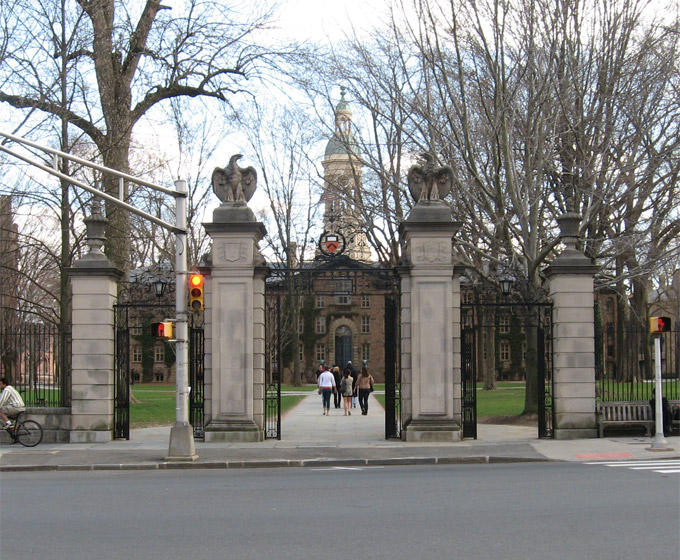Princeton, for those of you unacquainted, was founded in 1746 by the New Light Presbyterians, who originally named it the College of New Jersey and used it in order to train clergy/ministers. John Witherspoon, the president from 1768-1794 changed the focus of the university to training future leaders of America (pre-revolutionary war). During the Revolutionary war, the main building on campus, Nassau Hall, was occupied by British troops briefly. Additionally, you can still find cannon ball imprints at the bases of some of the older buildings.
The day started off fairly well: free parking, close to campus. I was impressed by Princeton's small-town feel. Botique shops, designer clothing stores, Eastern eateries, and best of all, froyo shops, lined the streets. The town captured a charming New England atmosphere, complete with a Christian monastery/study hall down the street (which at one point was affiliated with the university). Additionally, I managed to get my picture with the infamous Princeton Tigers, which guard the entrance to campus.
After indulging in some delicious froyo at a place called The Scoop, we headed over to campus, which was surrounded by a small brick fence topped with wrought iron. Right as we stopped to look at a map of the campus to figure out where the student union was, the sky, which had been growing increasingly overcast all day opened up in a downpour.We tried to wait it out under the awning of their art museum, but were afraid to miss the tour, so we made a mad dash to the visitors center. We were met by a large group of people, equally annoyed with the sudden change of weather, and equally as desperate to find the tour departure location (Nassau Hall, the first building erected on campus).
All the buildings, though beautiful, had begun to look the same. Finally, we happened upon the place where the tours were to leave from. The tour guides were incredibly friendly, some even taking their shoes off to splash through the puddles on campus. What our particular guide, Jenny, lacked in enthusiasm, she made up for with an unbelievable knowledge of the history of the school and an incredible gratefulness to Princeton for providing her with a fabulous education that she would not have been able to afford had it not been from a generous "no-payback" grant from the Financial Aid office.
We walked past some beautiful residential houses for students on campus. Princeton divides up incoming freshmen into residential colleges, where they can live for all 4 years. Undergrads typically live on campus all four years, while around 70 percent of the graduate students choose to do the same. You don't necessarily eat at these dorms, and there are a variety of 'food houses,' also known as "eating clubs" that serve everything from Asian cuisine to American burgers. Typically, these houses are invite-only, and provide a way for students to socialize and share/expand culinary expertise.
On a somewhat random note, I also stopped to talk to a Chemistry professor. Not only did the man actually resonate with me, but he wasn't at all stuck-up about the fact that he was teaching at one of America's top universities. I was kind of surprised when he told me there were around two dozen actual professors of chemistry at the university. For a campus of around 5,200 undergrads, I thought this was pretty impressive.
One thing that impressed me as well that our tour guide happened to mention was the iPrinceton app for iPhones, which was designed by Princeton computer science students. The app features athletics scores, campus news and email, access to BlackBoard (the same software running Compass at the U of I), as well as a laundry feature, telling you which machines were available.
Overall, I enjoyed Princeton, although not as much as I thought I would. Whether it was the weather or just the daunting challenge of trying to get into an Ivy League institution, I was sure after leaving that it was probably not somewhere I'd consider applying. However, for those of you looking for a beautiful campus, challenging academics, and a rich educational tradition, Princeton may be the place to look for you!


